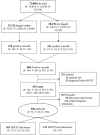Towards the first 90: impact of the national HIV self-test program on case finding and factors associated with linkage to confirmatory diagnosis in Taiwan
- PMID: 35324087
- PMCID: PMC8944217
- DOI: 10.1002/jia2.25897
Towards the first 90: impact of the national HIV self-test program on case finding and factors associated with linkage to confirmatory diagnosis in Taiwan
Abstract
Introduction: Being aware of one's HIV-positive status can help reduce unprotected sex and promote early treatment seeking. Therefore, HIV self-test (HIVST) programs may help control the HIV epidemic by case finding. The aims of this study were to determine the effect of HIVST programs on HIV case finding, time to confirmatory diagnosis and factors associated with linkage to confirmatory diagnosis in Taiwan.
Methods: The Centers for Disease Control in Taiwan initiated HIVST programs and imported 78,000 self-test kits in 2017 and 2019. Clients paid 7 US dollars for a self-test kit at facilities, vending machines or online. The programs set up an HIVST logistics management system; each kit had a unique barcode for monitoring the programs because purchases were anonymous. When clients provided their test results with photo barcodes online or at HIV/AIDS-designated hospitals, they received full monetary reimbursement. We conducted a quasi-experimental interrupted time-series (ITS) analysis that covered a period of 60 months from 2015 to 2019. We enrolled a retrospective cohort of reported HIV cases with initial positive results from HIVST programs between March 2017 and July 2020.
Results: The ITS analysis included data from 10,976 reported HIV cases from 2015 to 2019. The HIVST-positive cohort included 386 reported HIV cases, of whom 99.7% were males and 97% were men who have sex with men (MSM); the median age was 28 years. The ITS analysis showed a positive slope change in the number of reported HIV cases immediately in the beginning implementation month (coefficient: 51.09 in 2017 and 3.62 in 2019), but there was a significant decrease over time. It was a negative slope change by 9.52 cases per month in 2017 and 5.56 cases per month in 2019. In the HIVST-positive cohort, three of five individuals linked to HIV confirmatory diagnosis within 1 month after a positive self-test result, and an early linkage to confirmatory diagnosis was associated with HIVST disclosure (adjusted OR = 6.5; 95% CI: 3.9-10.6).
Conclusions: HIVST programs were associated with an increase in HIV case finding. Our findings suggest that countries with a high incidence of HIV among MSM populations should offer multichannel HIVST services.
Keywords: HIV epidemiology; HIV self-test; HIV testing; intervention; men who have sex with men; public health.
© 2022 The Authors. Journal of the International AIDS Society published by John Wiley & Sons Ltd on behalf of the International AIDS Society.
Conflict of interest statement
The authors have no competing interests.
Figures



Similar articles
-
Increasing Testing Options for Key Populations in Burundi Through Peer-Assisted HIV Self-Testing: Descriptive Analysis of Routine Programmatic Data.JMIR Public Health Surveill. 2021 Sep 30;7(9):e24272. doi: 10.2196/24272. JMIR Public Health Surveill. 2021. PMID: 34591018 Free PMC article.
-
Evaluation of factors associated with HIV self-testing Acceptability and Uptake among the MSM community in Nairobi, Kenya: A cross sectional study.PLoS One. 2023 Mar 9;18(3):e0280540. doi: 10.1371/journal.pone.0280540. eCollection 2023. PLoS One. 2023. PMID: 36893161 Free PMC article.
-
Uptake of HIV self-testing and linkage to treatment among men who have sex with men (MSM) in Nigeria: A pilot programme using key opinion leaders to reach MSM.J Int AIDS Soc. 2018 Jul;21 Suppl 5(Suppl Suppl 5):e25124. doi: 10.1002/jia2.25124. J Int AIDS Soc. 2018. PMID: 30033680 Free PMC article.
-
"I take it and give it to my partners who will give it to their partners": Secondary distribution of HIV self-tests by key populations in Côte d'Ivoire, Mali, and Senegal.BMC Infect Dis. 2023 May 24;22(Suppl 1):970. doi: 10.1186/s12879-023-08319-4. BMC Infect Dis. 2023. PMID: 37226113 Free PMC article. Review.
-
HIV Self-Testing Uptake and Intervention Strategies Among Men in Sub-Saharan Africa: A Systematic Review.Front Public Health. 2021 Feb 19;9:594298. doi: 10.3389/fpubh.2021.594298. eCollection 2021. Front Public Health. 2021. PMID: 33681120 Free PMC article.
Cited by
-
Prevalence, trends, and specialized palliative care utilization in Taiwanese children and young adults with life-limiting conditions between 2008 and 2017: a nationwide population-based study.Arch Public Health. 2024 Jul 3;82(1):99. doi: 10.1186/s13690-024-01315-3. Arch Public Health. 2024. PMID: 38961464 Free PMC article.
-
Leveraging HIV self-testing to achieve the UNAIDS 2025 targets in the South and Southeast Asia region.J Int AIDS Soc. 2024 Oct;27(10):e26357. doi: 10.1002/jia2.26357. J Int AIDS Soc. 2024. PMID: 39397317 Free PMC article.
References
-
- WHO . WHO recommends HIV self‐testing: evidence update and considerations for success: policy brief. Geneva: World Health Organization; 2019.
-
- Amstutz A, Lejone TI, Khesa L, Muhairwe J, Bresser M, Vanobberghen F, et al. Home‐based oral self‐testing for absent and declining individuals during a door‐to‐door HIV testing campaign in rural Lesotho (HOSENG): a cluster‐randomised trial. Lancet HIV. 2020;7(11):e752–61. - PubMed
MeSH terms
LinkOut - more resources
Full Text Sources
Medical

